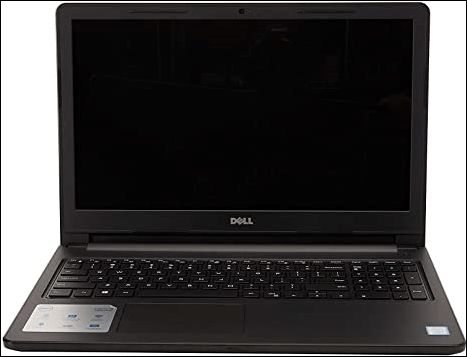When a Dell laptop powers on but only shows a black screen, there are several potential causes to investigate. A black screen on boot up often indicates an issue with the laptop’s hardware or operating system that is preventing the display from functioning properly and initializing the graphical interface.
Quick Fixes to Try
Before diving into troubleshooting the root causes, here are some quick and easy things to try that may resolve the issue:
- Force restart the laptop by holding the power button for 10-15 seconds to turn it off, then turn it back on.
- Adjust the screen brightness up in case the black screen is simply a dim display.
- Connect the laptop to an external monitor via HDMI or VGA to see if the display works on the external screen.
- Start the Dell laptop in safe mode to load a minimal interface and determine if a third party app is causing issues.
- Boot into the BIOS settings menu to determine if the laptop can POST successfully.
- Try resetting the laptop’s display settings by booting into safe mode and uninstalling/reinstalling the graphics drivers.
If the basic troubleshooting steps above do not resolve the issue, more advanced troubleshooting is required to pinpoint the cause.
Hardware Related Causes
Black screen issues that persist on a Dell laptop often stem from a hardware malfunction or failure. Some key hardware components to examine include:
Faulty Display/Screen
If the display itself is damaged or defective, it will fail to show the POST screen or operating system interface. Connect an external monitor to the Dell laptop. If the external display works properly but the built-in display is still black, that confirms a problem with the laptop screen itself. Replacing the display assembly would be needed to correct a defective laptop screen.
Loose Display Cable
Dell laptops route the display cable through the hinges. Over time, these cables can come loose from opening and closing the lid. This results in loss of video signal to the screen. Wiggling the display hinge while powered on can temporarily reconnect the display cable and restore the image. Permanently securing the cable with adhesive or tape will get the display functioning again.
Failed Inverter Board
Older Dell laptops use an inverter board to control screen backlighting. If this component fails, the inverter won’t be able to turn on the laptop’s backlight, resulting in a black screen. Replace the inverter board if faulty.
Loose RAM
If the RAM stick has become loosened from its slot from drops or bumps, it could cause a black screen on boot up. Reseat the RAM by removing it and inserting it firmly back into place to fix this issue.
Failed Hard Drive
A bad hard drive could lead to the operating system failing to load, resulting in black screen with flashing cursor. Try booting from a USB drive to isolate the hard drive failure. If the hard drive is not detected in the BIOS or doesn’t pass Dell’s onboard diagnostics, it likely needs to be replaced.
Failed Graphics Card
Some Dell laptops have dedicated GPUs for high performance graphics. If the graphics card is bad, video won’t be able to display on the screen properly. Running Dell diagnostics can confirm this by testing the integrated vs. dedicated GPUs. The fix would involve replacing the failed graphics card.
Software Related Causes
Alongside hardware failure, many software issues can also lead to the black screen problem:
Operating System Crash/Corruption
File system corruption or critical OS component failure could cause a black screen on startup. This may be fixable by running the automatic repair feature from the Windows recovery options. If repairing the OS fails, it may require reinstalling Windows or resetting to factory default state.
Third Party Software Conflict
Poorly coded or incompatible apps can sometimes interfere with the graphics stack and cause display issues leading to black screen. Booting in safe mode and uninstalling recently added programs can help isolate the problematic software. Updating or removing the app can resolve the issue.
Expired Operating System
Using an EOL (end of life) Windows OS version that is no longer supported on a Dell laptop may result in black screens due to missing updates and patches. Upgrading to a newer supported OS version is recommended.
Buggy Display Driver
Display driver bugs or conflicts can sometimes lead to a black screen issue, especially after a major Windows update. Test by booting in safe mode with default display drivers. If the problem disappears, it indicates a driver-related failure. Updating or rolling back display drivers typically resolves this.
Virus/Malware Infection
Severe malware infection could potentially modify system settings, corrupt OS files or interfere with the graphics stack in a way that causes black screen issues. Running extensive antivirus scans in safe mode and removing any infections discovered may fix this problem.
Advanced Troubleshooting
For black screen issues that persist after trying the above fixes, more advanced troubleshooting methods may be required:
- Run thorough hardware diagnostics using Dell SupportAssist or Dell PC Diagnostics utility
- Test components like RAM, HDD in another system to isolate failures
- Check Windows event logs for critical errors during boot process
- Perform a clean reinstall of the operating system
- Attempt BIOS recovery/reset if system is not POSTing
- Try an external video card if the integrated GPU appears faulty
Additionally, ensuring BIOS, chipset, and other device drivers are fully up to date can help resolve any incompatibilities that may cause black screen on boot.
Conclusion
A black screen on Dell laptop boot up usually indicates a hardware or software malfunction. For hardware issues, inspecting key components like the display, RAM, hard drive, and motherboard can reveal failure. On the software side, check for OS corruption, driver conflicts and malware. Trying quick fixes first along with isolation testing helps zero in on root cause. Advanced Dell diagnostics and OS recovery provide final resorts to troubleshoot tricky black screen problems.
